EDIT 2: It seems this isn't from CLRS (I assumed it was because it followed the same format of CLRS code that was given to us in this Algos and DS course). Still, in this course we were given this code as being "Dijkstra's Algorithm".
I read Why doesn't Dijkstra's algorithm work for negative weight edges? and Negative weights using Dijkstra's Algorithm (second one is specific to the OP's algorithm I think).
Looking at the Pseudocode from CLRS ("Intro to Algorithms"), I don't understand why Dijkstra wouldn't work on those examples of graphs with negative edges.
In the pseudocode (below), we Insert nodes back onto the heap if the new distance to them is shorter than the previous distance to them, so it seems to me that the distances would eventually be updated to the correct distances.
For example:
The claim here is that (A,C) will be set to 1 and never updated to the correct distance -2.
But the pseudocode from CLRS says that we first put C and B on the Heap with distances 1 and 2 respectively; then we pop C, see no outgoing edges; then we pop B, look at the edge (B,C), see that Dist[C] > Dist[B] + w(B,C), update Dist[C] to -2, put C back on the heap, see no outgoing edges and we're done.
So it worked fine.
Same for the example in the first answer to this question: Negative weights using Dijkstra's Algorithm
The author of the answer claims that the distance to C will not be updated to -200, but according to this pseudocode that's not true, since we would put B back on the heap and then compute the correct shortest distance to C.
(pseudocode from CLRS)
Dijkstra(G(V, E, ω), s ∈ V )
for v in V do
dist[v] ← ∞
prev[v] ← nil
end for
dist[s] = 0
H←{(s,0)}
while H̸=∅ do
v ← DeleteMin(H)
for (v, w) ∈ E do
if dist[w] > dist[v] + ω(v, w) then
dist[w] ← dist[v] + ω(v, w)
prev[w] ← v
Insert((w, dist[w]), H)
end if
end for
end while
EDIT: I understand that we assume that once a node is popped off the heap, the shortest distance has been found; but still, it seems (according to CLRS) that we do put nodes back on the heapif the distance is shorter than previously computed, so in the end when the algorithm is done running we should get the correct shortest distance regardless.
